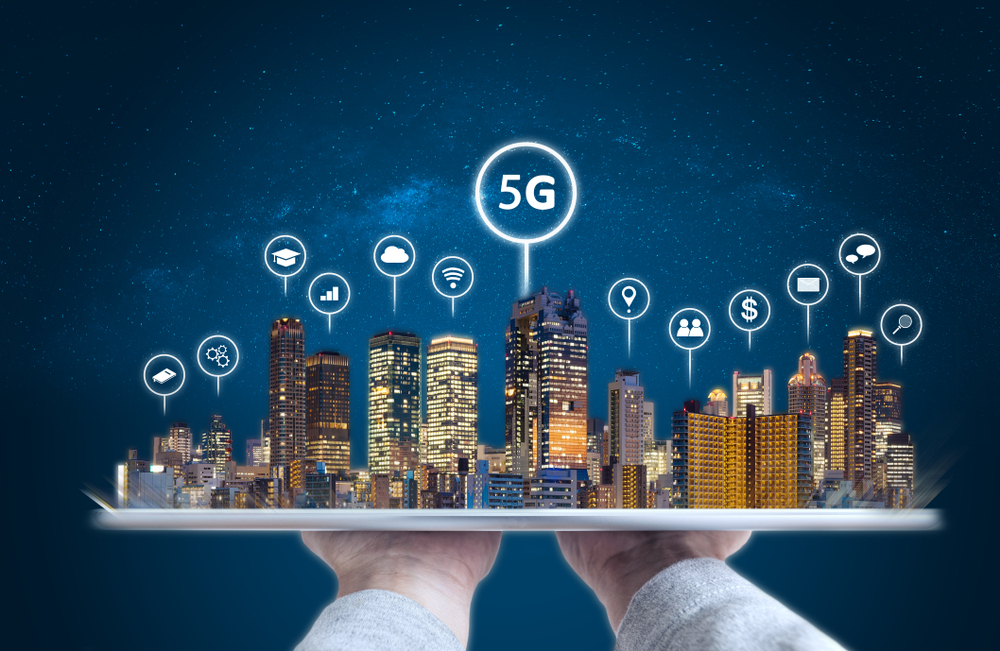The revolutionary potential of 5G
SPONSORED CONTENT – With the right investment and support, the next generation of connectivity could transform society

The modern world is powered by data – you only need to look at how we're using technology to adapt to the events of 2020 to see how important it is to our lives. To meet growing global demand and fully realise the potential of the technologies of tomorrow, from autonomous vehicles to smart cities, we need to continue to evolve network capabilities. Enter 5G.
The GSMA (the Global System for Mobile Communications) predicts that 5G will account for a fifth of global connections by 2025, with the uptake being particularly strong in developed areas of Asia, North America and Europe. 5G is going to be – and already is – big business.
What exactly is 5G?
5G is the fifth-generation of wireless mobile technology, promising to bring faster data transfer speeds along with other benefits such as low latency. Rather than replacing 4G, the current network standard, it is designed to work alongside it, tapping into a different range of radio frequencies. As with all mobile networks, the radio frequency spectrum is a crucial part of the 5G landscape. 5G will make use of sub-6 GHz frequencies, which are able to cover vast distances, and mmWave frequencies (between 30 GHz and 300 GHz), which offer impressive speed.
MoneyWeek
Subscribe to MoneyWeek today and get your first six magazine issues absolutely FREE

Sign up to Money Morning
Don't miss the latest investment and personal finances news, market analysis, plus money-saving tips with our free twice-daily newsletter
Don't miss the latest investment and personal finances news, market analysis, plus money-saving tips with our free twice-daily newsletter
Once the infrastructure is in place, 5G should vastly improve on 4G in scale and speed. High data transfer rates combined with low latency, good coverage and reliability should solve many of the problems phones still tend to struggle with – handling complex applications such as video games and minimising congestion when large groups of people access the network in one area.
But 5G can offer much more than faster phone connections. The ability to handle a higher number of connections than 4G is a key 5G benefit. It opens the door to a revolution of the so-called Internet of Things (IoT), advancing smart homes, smart cities, potentially replacing home WiFi and improving on emerging technologies such as autonomous vehicles and artificial intelligence (AI).
However, we won’t see all the benefits of 5G overnight. It will take years of investment to build the right infrastructure to support 5G, and there is still a long way to go to get businesses and consumers fully on board.
The evolution of mobile technology
Mobile connections have come a long way in a short space of time. As the name suggests, there are four generations of connectivity preceding 5G, each significantly advancing the technology, these are:
- 1G – Launched in Tokyo in 1979, the first generation of mobile networks was analogue. As a fledgeling technology, it had its downsides – the sound quality was low and the coverage was limited, plus there was no encryption.
- 2G – Developed in the 1990s, the second generation of mobile technology, which was digital and made text messages possible, really enabled the widespread use and accessibility of mobile phones.
- 3G – A significant breakthrough in mobile communication, 3G’s advanced data capabilities made video calls possible and enabled the smartphone. The 3G era saw the launch of the iPhone in 2007, although the original model wasn’t 3G compatible.
- 4G – Much faster than 3G and able to support modern, digital lifestyles full of music streaming and HD video, 4G is currently the standard across the globe. In 2019 it accounted for 52% of total connections.
The 5G revolution
The race to get 5G-ready is already on. Mobile 5G is now available from 46 operators in 24 markets worldwide and a further 79 operators in 39 other markets have announced plans to launch mobile 5G services. Operators are expected to invest $1.1 trillion worldwide between 2020 and 2025 in mobile CapEx, roughly 80% of which will be in 5G networks.
5G isn’t just a simple switch, it requires investment in completely new infrastructure, developed to deliver on its big promises of high speed, reliable coverage, low latency and the ability to integrate technologies such as edge computing. The network infrastructure being built to support 5G is designed to contain computing capabilities as well as enabling connectivity. This gives 5G great potential but comes with security concerns – as played out in the ongoing Huawei saga.
The potential of 5G to transform all areas of our lives from entertainment to manufacturing is leading operators to diversify their offerings and move away from just telecoms services. For example, US telecommunications giant AT&T recently acquired Time Warner and DirecTV, meaning entertainment now makes up 40% of its total revenue. There is also collaboration going on between big players in the 5G race. For instance, Amazon has partnered with Verizon on 5G network edge computing, offering the ability to run AWS (Amazon Web Services) applications with ultra-low latency through the Verizon 5G network.
5G will drive future digital innovation and economic growth as it develops alongside technologies such as AI and IoT. With the right government and commercial investment and support, its connectivity benefits could be applied to almost any industry, transforming society as we know it. It is forecast that 5G technologies will contribute a staggering $2.2 trillion to the global economy between 2024 and 2034. From homes to hospitals to entire cities, smart technology enabled by 5G will likely feature in every aspect of our lives.
If you’re looking to invest in 5G, CMC Markets now offers you a straightforward way to take a position on the entire sector and helps spread the risk between multiple companies. Whatever your view, long or short, bullish or bearish, you can express it using CMC's share baskets. Share baskets offer investors a cost-effective way to trade a wide range of industries and themes, while diversifying their exposure within a theme. The 5G share basket offers exposure to 21 companies carefully selected by CMC market analysts, including: Amazon.com, Apple, Cisco Systems, Intel, AT&T, Verizon Communications Inc (US) and Qualcomm.
Find out more about CMC’s share baskets and test-run a demo account
Disclaimer: Spread bets and CFDs are complex instruments and come with a high risk of losing money rapidly due to leverage. 79% of retail investor accounts lose money when spread betting and/or trading CFDs with this provider. You should consider whether you understand how spread bets and CFDs work and whether you can afford to take the high risk of losing your money.
Get the latest financial news, insights and expert analysis from our award-winning MoneyWeek team, to help you understand what really matters when it comes to your finances.
MoneyWeek is written by a team of experienced and award-winning journalists, plus expert columnists. As well as daily digital news and features, MoneyWeek also publishes a weekly magazine, covering investing and personal finance. From share tips, pensions, gold to practical investment tips - we provide a round-up to help you make money and keep it.
-
 How much would it cost you to buy a house in Great Britain's happiest places?
How much would it cost you to buy a house in Great Britain's happiest places?Average asking prices for a property in the happiest place in Britain are below the national average
-
 How the Budget will hurt you: MoneyWeek Talks
How the Budget will hurt you: MoneyWeek TalksPodcast An Autumn budget podcast special episode, featuring MoneyWeek editors Kalpana Fitzpatrick, Andrew van Sickle and Cris Heaton.

